Content for TS 23.283 Word version: 19.0.0
1…
10…
10.2…
10.3…
10.3.2
10.3.3…
10.3.4…
10.3.5…
10.3.6…
10.3.7…
10.3.8…
10.4…
10.5…
10.6…
10.6.2…
10.6.3…
10.7…
10.8…
10.11…
10.12…
10.14…
10.15…
10.17…
10.11 Location
10.11.1 Location of current talker
10.11.2 Location of current talker (MCPTT server to IWF)
10.11.3 Location of current talker (IWF to MCPTT server)
10.11.4 Information flows for location information between the IWF and the LMS
10.11.4.1 Location information services between the IWF and the LMS
10.11.4.2 Location information procedures between the IWF and the LMS
10.11.4.2.1 On-demand request of location information procedure
10.11.4.2.2 Location information notification procedure
10.11.4.2.3 Location information subscription procedure
10.11.4.2.4 Location information cancel subscription procedure
...
...
10.11 Location p. 152
10.11.1 Location of current talker p. 152
Subclause 10.6.2.7 of TS 23.379 describes a high-level procedure to provide the location of the current talker to all the receiving MCPTT users.
10.11.2 Location of current talker (MCPTT server to IWF) p. 152
Figure 10.11.2-1 shows the high-level procedure to for MCPTT service to provide the location information about the current talking user to all the receiving MCPTT users and the IWF.
Pre-conditions:
- There is on-going group call involving MCPTT client 1 and MCPTT client 2 and the IWF.
- MCPTT client 1 is the current talking user.
- MCPTT server has obtained the location information of MCPTT client 1.
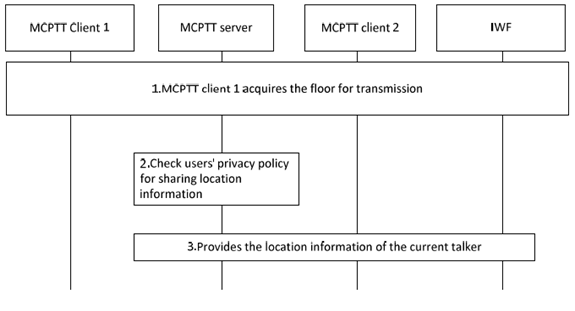
Step 1.
MCPTT client 1 gets the floor to transmit voice media.
Step 2.
The MCPTT server checks the privacy policy (authorisation to provide location information to other MCPTT users on a call when talking, as defined in TS 23.379 Annex A.3) of the current talking MCPTT user to decide if the location information of MCPTT client 1 can be provided to other MCPTT users on the call.
Step 3.
If the privacy policy permits, the MCPTT server provides the location information of MCPTT client 1 to MCPTT client 2 and the IWF. The procedures for this are described in subclause 10.9.3.6 of TS 23.280. Optionally, the location information may be provided in the floor taken message sent to MCPTT client 2 and the IWF according to subclause 10.9.1.3.1 of TS 23.379, if the privacy policy permits.
10.11.3 Location of current talker (IWF to MCPTT server) p. 153
Figure 10.11.3-1 shows the high-level procedure to for the IWF to provide the location information about the current LMR talking user to all the receiving MCPTT users.
Pre-conditions:
- There is on-going group call involving MCPTT client 1 and MCPTT client 2 and the IWF.
- An LMR user is the current talking user through the IWF.
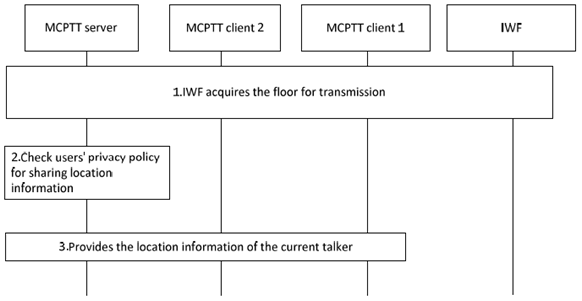
Step 1.
The IWF gets the floor to transmit voice media.
Step 2.
The MCPTT server checks the privacy policy (authorisation to provide location information to other MCPTT users on a call when talking, as defined in TS 23.379 Annex A.3) of the current talking IWF user to decide if the location information of the user on the IWF can be provided to other MCPTT users on the call.
Step 3.
The MCPTT server provides the location information of the IWF user to MCPTT client 1 and MCPTT client 2. The procedures for this are described in subclause 10.9.3.6 of TS 23.280. Optionally, the location information may be provided in the floor taken message sent to MCPTT client 2 and the IWF according to subclause 10.9.1.3.1 of TS 23.379.
10.11.4 Information flows for location information between the IWF and the LMS |R18| p. 154
10.11.4.1 Location information services between the IWF and the LMS p. 154
10.11.4.1.1 IWF Location information report p. 154
Table 10.9.2.2-4 in TS 23.280 describes the information flow to support the handling of a location information report from the LMS to the IWF and from the IWF to the LMS.
10.11.4.1.2 IWF Location information request p. 154
Table 10.9.2.3-4 in TS 23.280 describes the information flow to support the handling of an IWF Location information request from the LMS to the IWF and from the IWF to the LMS.
10.11.4.1.3 IWF Location information subscription request p. 154
Table 10.9.2.5-3 in TS 23.280 describes the information flow from the LMS to the IWF and from the IWF to the LMS for an IWF Location information subscription request.
10.11.4.1.4 IWF Location information subscription response p. 154
Table 10.9.2.6-1 in TS 23.280 describes the information flow from the LMS to the IWF and from the IWF to the LMS for an IWF Location information subscription response.
10.11.4.1.5 IWF Location information notification p. 155
Table 10.9.2.7-3 in TS 23.280 describes the information flow from the LMS to the IWF and from the IWF to the LMS for an IWF Location information notification.
10.11.4.1.6 IWF Location information cancel subscription request p. 155
Table 10.9.2.8-3 in TS 23.280 describes the information flow from the LMS to the IWF and from the IWF to the LMS for an IWF Location information cancel subscription request.
10.11.4.1.7 IWF Location information cancel subscription response p. 155
Table 10.9.2.9-3 in TS 23.280 describes the information flow from the LMS to the IWF and from the IWF to the LMS for an IWF Location information cancel subscription response.
10.11.4.2 Location information procedures between the IWF and the LMS p. 155
10.11.4.2.1 On-demand request of location information procedure p. 155
10.11.4.2.1.1 On-demand request of location information procedure (LMS to IWF) p. 155
The MC service server or location management client in the MC system can request an LMR user's location information, which is in the LMR system, at any time by sending an IWF Location information request to the IWF at the LMR system.
The LMR user appears to the MC system as an MC service user. The IWF provides interworking to obtain location information for the LMR user associated with the MC service identity it receives. The IWF can translate, as needed, between MC service identities and identities used within the LMR system.
Figure 10.11.4.2.1.1-1 illustrates the high level procedure of on-demand request of location information.
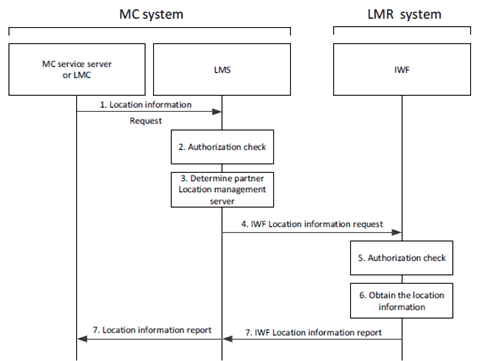
Step 1.
The MC service server or a LMC in the MC system requests from the LMS on-demand location information of the LMR user that appears as an MC service user.
Step 2.
The LMS in the MC system checks if the provided information along with the configuration permit the request to proceed.
Step 3.
The LMS in the MC system determines that the request has a target in the LMR system.
Step 4.
The LMS in the MC system sends the IWF Location information request to the IWF in the LMR system according to the described information flow in clause 10.11.4.1.2.
Step 5.
The IWF in the LMR system can choose to authorize the request.
Step 6.
The IWF at the LMR system determines the location information for the LMR user associated with the MC service user identified in the request.
Step 7.
The IWF at the LMR system sends the IWF Location information report, described in clause 10.11.4.1.1, to the LMS in the MC system. The LMS forwards the location information report to the MC service server or the LMC.
10.11.4.2.1.2 On-demand request of location information procedure (IWF to LMS) p. 156
The IWF in the LMR system can request an MC service user's location information, which is in the MC system, at any time by sending an IWF Location information request to the LMS at the MC system. The IWF can translate, as needed, between MC service identities and identities used within the LMR system.
Figure 10.11.4.2.1.2-1 illustrates the high level procedure of on-demand request of location information.
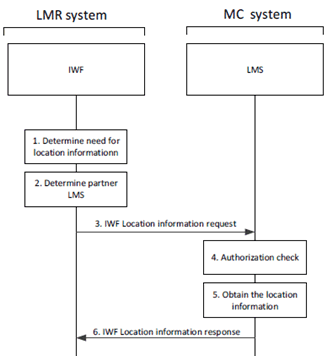
Step 1.
The IWF in the LMR system determines that location information is needed for an MC service user.
Step 2.
The IWF in the LMR system determines that the MC service user is in the MC system.
Step 3.
The IWF in the LMR system sends the IWF Location information request to the LMS in the MC system according to the described information flow in clause 10.11.4.1.2.
Step 4.
The LMS in the MC system authorizes the request.
Step 5.
The LMS in the MC system determines the location information for the MC service user identified in the request.
Step 6.
The LMS in the MC system sends the IWF Location information report, described in clause 10.11.4.1.1, to the IWF in the LMR system.
10.11.4.2.2 Location information notification procedure p. 157
10.11.4.2.2.1 Location information notification procedure (IWF to LMS) p. 157
The IWF in the LMR system provides location information, based on some decision or event, to the LMS. The IWF can translate, as needed, between MC service identities and identities used within the LMR system.
Figure 10.11.4.2.2.1-1 illustrates the high level procedure of notification of location information.
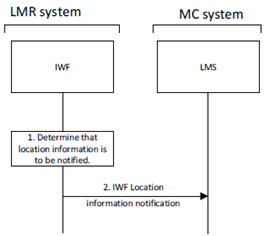
Step 1.
The IWF in the LMR system determines that it has location information available that is to be notified to the LMS in the MC system.
Step 2.
The IWF in the LMR system sends the IWF Location information notification to the LMS in the MC system, according to the described information flow in clause 10.11.4.1.5.
10.11.4.2.2.2 Location information notification procedure (LMS to IWF) p. 158
The LMS in the MC system provides location information to the IWF in the LMR system. The IWF can translate, as needed, between MC service identities and identities used within the LMR system.
Figure 10.11.4.2.2.2-1 illustrates the high level procedure of notification of location information.
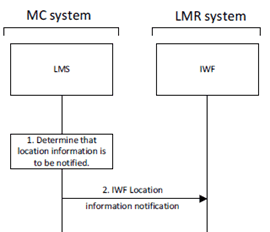
Step 1.
The LMS in the MC system determines that it has location information available that is to be notified to the IWF in the LMR system.
Step 2.
The LMS in the MC system sends the IWF Location information notification to the IWF in the LMR system, according to the described information flow in clause 10.11.4.1.5.
10.11.4.2.3 Location information subscription procedure p. 159
10.11.4.2.3.1 Location information subscription procedure (LMS to IWF) p. 159
An IWF Location information subscription request is sent from the MC system to the IWF. The IWF in the LMR system sends an IWF location information subscription response. The IWF can translate, as needed, between MC service identities and identities used within the LMR system.
Figure 10.11.4.2.3.1-1 illustrates the high level procedure of subscription to location information from the LMS in the MC system to the IWF in the LMR system.
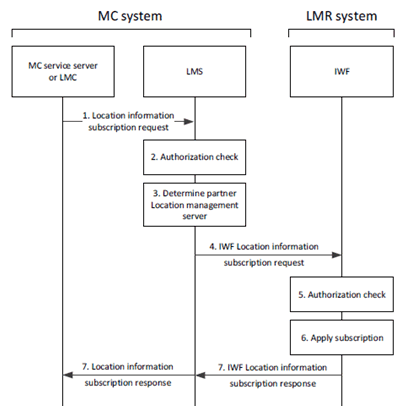
Step 1.
The MC service server or the LMC in the MC system sends a request for subscription to event-triggered location information of LMR users that appear as MC service users in the LMR system by sending a location information subscription request to the LMS in the MC system, according to the described information flows in clause 10.9.2.5 in TS 23.280.
Step 2.
The LMS in the MC system checks if the provided information along with the configuration permit the request to proceed.
Step 3.
The LMS in the MC system determines that the request has a target in an LMR system.
Step 4.
The LMS in the MC system sends the IWF Location information subscription request to the IWF in the LMR system, according to the described information flow in clause 10.11.4.1.3.
Step 5.
The IWF in the LMR system can check if the provided information along with the configuration permit the request to proceed.
Step 6.
The IWF in the LMR system applies the subscription.
Step 7.
The IWF in the LMR system sends the IWF Location information subscription response to the LMS in the MC system according to the described information flow in clause 10.11.4.1.4. The LMS in the MC system can respond to the LMC or MC server in the MC system per the procedures of TS 23.280.
10.11.4.2.3.2 Location information subscription procedure (IWF to LMS) p. 160
An IWF Location information subscription request is sent from the MC system to the IWF. The IWF in the LMR system sends an IWF Location information subscription response. The IWF can translate, as needed, between MC service identities and identities used within the LMR system.
Figure 10.11.4.2.3.2-1 illustrates the high level procedure of subscription to location information from the LMS in the MC system to the IWF in the LMR system.
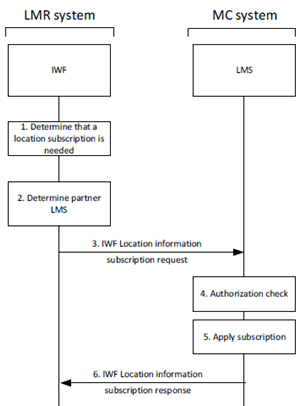
Step 1.
The IWF in the LMR system determines that it needs to subscribe to location information notifications for an MC service user.
Step 2.
The IWF in the LMR system determines that the request has a target in the MC system.
Step 3.
The IWF in the LMR system sends the IWF Location information subscription request to the LMS in the MC system, according to the described information flow in clause 10.11.4.1.3.
Step 4.
The LMS in the MC system checks if the provided information along with the configuration permit the request to proceed.
Step 5.
The LMS in the MC system applies the subscription.
Step 6.
The LMS in the MC system sends the IWF Location information subscription response to the LMS in the MC system according to the described information flow in clause 10.11.4.1.4.
10.11.4.2.4 Location information cancel subscription procedure p. 161
10.11.4.2.4.1 Location information cancel subscription procedure (LMS to IWF) p. 161
The LMC in the MC system receives location information updates according to the subscriptions requested in the LMR system per clause 10.11.4.2.3. Those subscriptions can be cancelled anytime from the MC system. The IWF can translate, as needed, between MC service identities and identities used within the LMR system.
Figure 10.11.4.2.4.1-1 illustrates the high level procedure of the subscription cancellation to location information from the MC system to the LMR system.
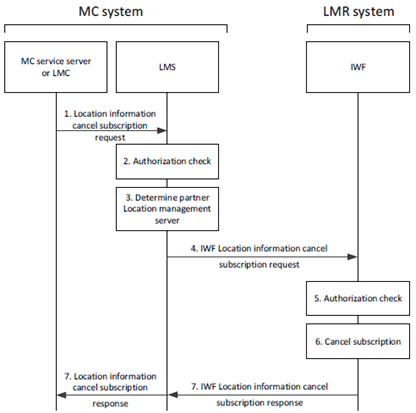
Step 1.
The MC service server or the LMC in the MC system requests the cancellation of subscriptions to event-triggered location information of LMR users that appear as MC service users in the LMR system by sending location information cancel subscription requests to the LMS in the MC system, according to the described information flows in clause 10.9.2.8 in TS 23.280.
Step 2.
The LMS in the MC system checks if the provided information along with the configuration permit the request to proceed.
Step 3.
The LMS in the MC system determines that the request has a target in an LMR system.
Step 4.
The LMS in the MC system sends the IWF Location information cancel subscription request to the IWF in the LMR system, according to the described information flow in clause 10.11.4.1.6.
Step 5.
The IWF in the LMR system can check if the provided information along with the configuration permit the request to proceed.
Step 6.
The IWF in the LMR system cancels the subscription.
Step 7.
The IWF in the LMR system sends the IWF Location information cancel subscription response to the LMS in the MC system, according to the described information flow in clause 10.11.4.1.7. The LMS can forward the location information cancel subscription response per the procedures in TS 23.280.
10.11.4.2.4.2 Location information cancel subscription procedure (IWF to LMS) p. 162
The IWF in the LMR system receives location information updates according to the subscriptions requested in the MC system per clause 10.11.4.2.3.2. Those subscriptions can be cancelled anytime from the LMR system. The IWF can translate, as needed, between MC service identities and identities used within the LMR system.
Figure 10.11.4.2.4.2-1 illustrates the high level procedure of the subscription cancellation to location information from the LMR system to the MC system.
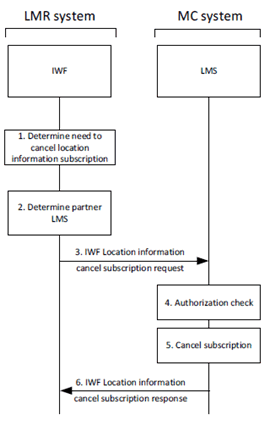
Step 1.
The IWF in the LMR system determines that a location information subscription is to be cancelled.
Step 2.
The IWF in the LMR system determines that the request has a target in the MC system.
Step 3.
The IWF in the LMR system sends the IWF Location information cancel subscription request to the LMS in the MC system, according to the described information flow in clause 10.11.4.1.6.
Step 4.
The LMS in the MC system checks if the provided information along with the configuration permit the request to proceed.
Step 5.
The LMS in the MC system cancels the subscription.
Step 6.
The LMS in the MC system sends the IWF Location information cancel subscription response to the IWF in the LMR system, according to the described information flow in clause 10.11.4.1.7.